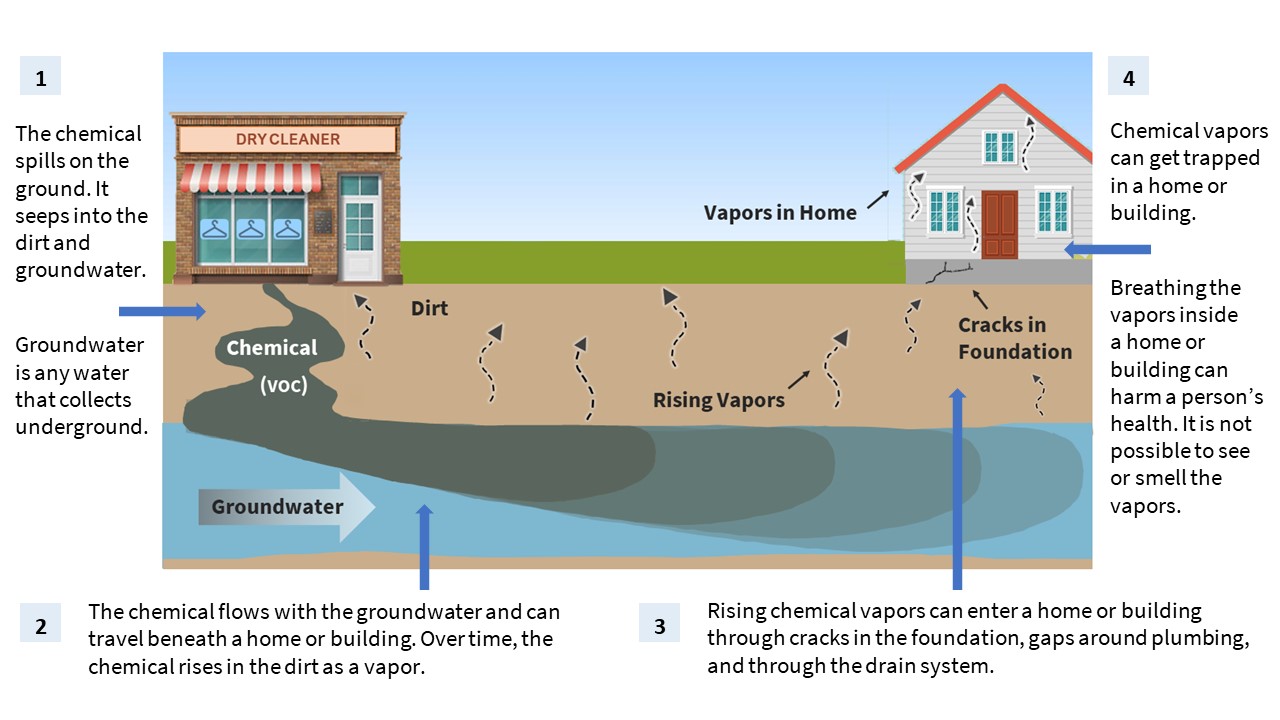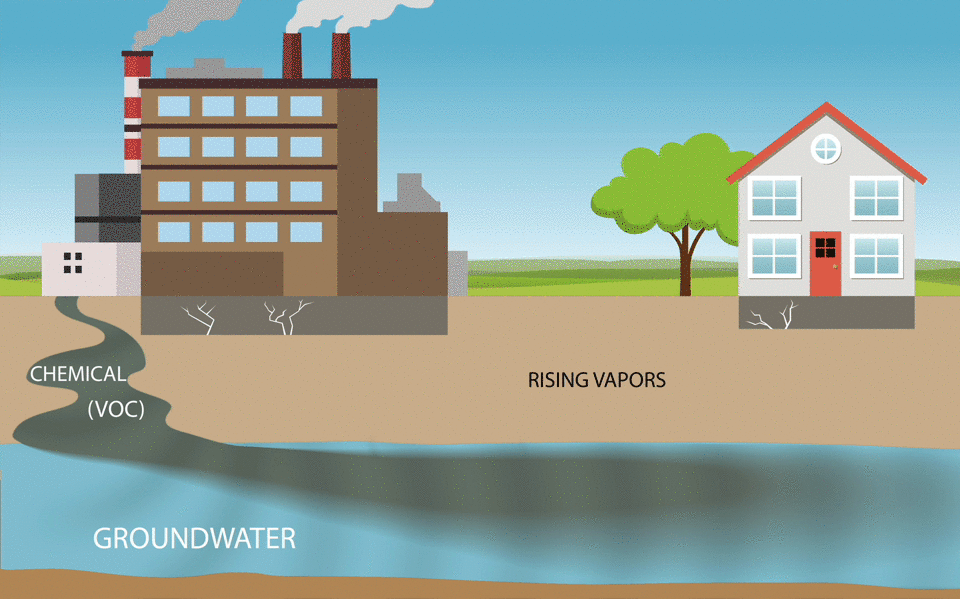Vapor Intrusion
What is vapor intrusion?
Vapor intrusion can harm people's health. Vapor intrusion happens when chemicals from polluted soil and groundwater form vapors that rise through the ground and enter nearby homes or buildings. When these vapors mix with the air inside a home or building, they can cause health problems.
What are volatile organic compounds (VOCs)?
VOCs are a common type of chemicals that cause vapor intrusion. Below are a few facts about VOCs:
-
VOCs are chemicals that easily evaporate. There are different types of VOCs.
-
Various types of businesses collect, store, and use VOCs to remove stains from fabrics, clean grease off of metal parts, thin paint, or manufacture gasoline. These businesses include dry cleaners, manufacturing facilities, auto repair shops, and gas stations (to name a few).
-
VOCs are typically stored in containers as a liquid and easily evaporate into the air as vapors. If these vapors mix with the air inside a home or building, they can cause health problems.
How does vapor intrusion happen?
Sometimes VOCs spill, leak, or are dumped on the ground at the businesses that use them. When the VOCs are not cleaned up, they can sink deep into the dirt and mix with the groundwater. Groundwater is any water that collects underground. It moves slowly and typically in one direction. When VOCs mix and flow with the groundwater they can travel beneath a home or building.
VOCs in dirt and groundwater evaporate and rise through the ground as vapors. The rising vapors can get inside homes or buildings. The vapors often enter through cracks in a building's foundation, gaps around plumbing, or through a drain system. Breathing in VOC vapors can harm people's health. For many types of VOCs, it is not possible to see or smell the vapors.
Even a VOC spill or leak that happened a long time ago can still be harmful today.


How can vapor intrusion affect my health?
Breathing VOC vapors can harm a person's health. The extent to which VOC vapors are harmful depends on how much of the chemical a person breathes in and for how long. Some VOCs can be more toxic to specific groups of people, including people who are pregnant and nursing, children, older adults, and people with chronic diseases or compromised immune systems. If you have health concerns, please contact your medical provider.
Two of the most common VOCs found in areas with vapor intrusion problems are PCE (Tetrachloroethylene) and TCE (Trichloroethylene). Exposure to TCE during the first trimester of pregnancy is a serious concern. Possible health problems from exposure to PCE or TCE include:
-
Dizziness, sleepiness, headache, problems with coordination
-
Changes in mood, memory, attention, or vision
-
Harm to the brain, liver, kidneys, blood, heart, reproduction, or immune system
-
Increased risk for certain cancers
-
Harm to a baby in the womb
Factsheets on the health effects of common VOCs that can cause vapor intrusion problems:
|
How is a vapor intrusion problem discovered?
When a government regulatory agency identifies a contaminated site, scientists investigate whether there might be a risk of vapor intrusion to nearby communities. First, the scientists gather information about the type, amount, and how far the chemicals may have spread. Then they may test the soil, vapors in the soil (soil gas), groundwater, and/or the indoor air in nearby buildings.
If a government regulatory agency discovers a vapor intrusion problem inside a home or building, they will work with the property owner to find ways to stop or reduce the problem. The factsheets below explain different ways government agencies can solve vapor intrusion problems. The State of Michigan created a video which shows how a government agency might investigate and fix a vapor intrusion problem.
In the meantime, opening windows can bring fresh air into a home or building and prevent VOCs from building up to unsafe levels.
Factsheets on how vapor intrusion problems are discovered and can be addressed:
|
Resources for medical providers
The federal Agency for Toxic Substances and Disease Registry (ATSDR) offers a wide range of
resources for primary care providers on environmental health, including patient exposure history forms, materials on toxic chemicals, and self-paced courses (CME credits).
California's Pediatric Environmental Health Specialty Unit (PEHSU) is available to respond to requests for information on reproductive and children's environmental health. The PEHSU can offer advice on prevention, diagnosis, management, and treatment of environmentally-related health effects in children and people of reproductive age. PEHSU is funded by the ATSDR.
Who to contact for more information
-
California Department of Public Health – Environmental Health Investigations Branch | Phone: 501-620-5764
| Email:
AskEHIB@cdph.ca.gov
-
California Department of Toxic Substances Control (State regulatory agency responsible for cleaning up contaminated sites) | Phone: 800-728-6942 | Email: RAO@dtsc.ca.gov
-
California State Water Resources Control Board (State regulatory agency responsible for cleaning up contaminated sites) | Groundwater Cleanup (webpage)